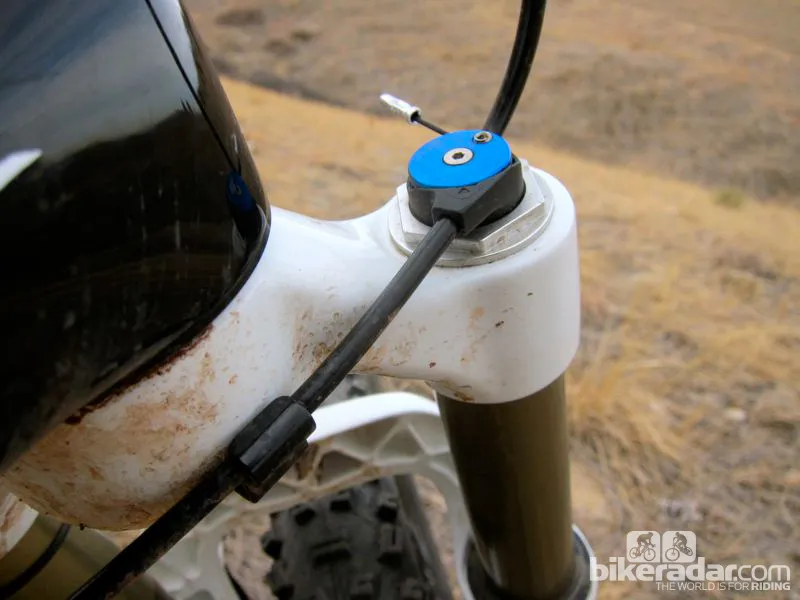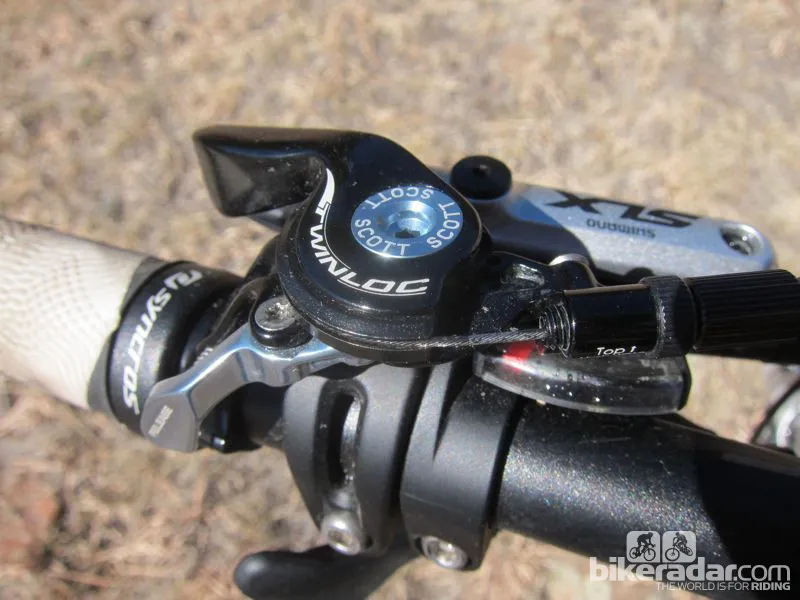In Scott's 2013 lineup, the closest thing to the 26in-wheeled Genius bikes of years past is the all-new 700 series. With a ground-up redesign since last year, the two biggest changes in a seemingly endless list are the 27.5in and 29er wheel options, and the omission of the classic Genius pull shock.
Swapping out the pull shock for a push model has shaved a claimed 200g off the frame.
Ride & handling: Takes some getting used to
From the first ride, the Genius 720 quickly gives the impression that it has deep roots in XC. The suspension simply doesn't come close to feeling anything like other 150mm travel designs, even in the fully open Descend mode.
Part of that ride trait might be down to the TwinLoc valving preventing the Nude 2 shock from being fully active. Regardless of the culprit, though, the Genius demands to be descended on with more caution than some of its competitors, at least when it comes to playful speeds on rocky, technical trail.
It took a handful of rides to adjust our ride style accordingly, with a litmus test of flatting on each of the first three outings, by virtue of expecting the suspension to suck up little trail edges that usually never cause an issue for other bikes with less travel.
The Scott still descended like a much racier, 100mm travel bike, and generally froze up through bumpy trails that asked it to deal with sequential hits.

This year’s Genius looks much more like the Spark without its pull shock
On-the-fly TwinLoc suspension adjustment has three settings controlled by a handlebar-mounted, dual-lever remote which also simultaneously adjusts settings on the Fox 34 CTD fork. You get a pick of Lockout, Traction and Descend modes, with rear wheel travel being reduced to 100mm in Traction.
Adjusting the Nude 2's the rebound damping to wide open, or within one click of it, helped the Genius' trail manners at the cost of decreased pedalling efficiency, even in Traction mode. If the 720 was as svelte as an XC bike there'd be a little more room for forgiveness in a somewhat unforgiving ride, but weighing in at 13.49kg (29.75lb) without pedals the Genius 720 is a touch portly for a carbon trail/all-mountain bike.
Beyond sheer trail compliancy, the Genius' geometry offers a playful, if slightly subdued, ride. The ability to dial in head tube and bottom bracket geometry is a big bonus, as not all regions require the same setup. Our bike showed up in the 'lower' setting, which offered great cornering but at the price of reduced pedal clearance through rocky singletrack.
The 'high' setting was much more appropriate in our Colorado testing region, and still felt plenty stable through turns while allowing a noticeable increase in pedal clearance.
The relatively long 17.3in chainstays numbed front-end playfulness a touch, and didn't do much to help on steep switchbacks. Overall, though, they didn't completely mute the handling and the Genius felt lively and responsive when both wheels were on the ground, but it tried to keep them there and lost some trail manners when one or both did make a break for it.
The TwinLoc remote's adjustability was the key to offering pedaling efficiency in the single-pivot design, and more often than not the Genius was set to Lockout mode when the cranks were turning on anything short of a full-blown descent.
Traction mode usually felt too inefficient on relatively smooth trail, by way of bobbing and sagging, even when we ran less sag than suggested. And Descend mode really robbed each pedal stroke of its power transfer, to the point of it only being used for true descents.

TwinLoc adjusts both front and rear suspension
Because we had to overuse the Lockout setting to satiate pedal efficiency tastes, the shock bushings wore out prematurely, showing noticeable play within a dozen rides. We think that, with the ability to increase pedal efficiency at the the flip of a bar-mounted switch, chances are many riders who seek similar pedal performance will run into the same issue.
Our shock tended to wonder on the linkage, too, which seemed to be the cause of a nasty squeak quickly mitigated by re-centering the shock and greasing all neighboring linkage. This is a problem we've experienced before on older Scott test bikes.
Speaking of the TwinLoc remote, as much as it clutters the cockpit by bringing the total cable/housing number to six, it is nice to have so much control at your fingertips. With the Genius' suspension habits the remote was in constant use – often in tandem with up and down shifting – and never so much as hiccuped an issue. It does add some complexity to the ride, especially when the suspension design it controls asks to be constantly dialed in, so it might not be for everyone.
Frame & equipment: Super-sized and with TwinLoc tech
Looking much more like a Scott Spark than any Genius of the last decade, the new 150mm travel Genius 720 frame is a clean, if not elegant, rendition of a single-pivot design.
Oversizing is Scott's theme here, with a new BB92 press-in bottom bracket, larger pivot points and accompanying hardware, and a supersized version of its proprietary Integrated Molding Process from the tapered head tube to the chainstays. All of this is said to improve frame stiffness while helping reduce weight by approximately 150g over last year's chassis. Including the swapped-out shock that's an impressive loss of approximately 350g.
Compatibility and flexibility are at the forefront of the new Genius. The rear dropouts are suitable for 142x12mm, 135x12mm and 135x10mm quick-releases, and by flipping two chips in the shock linkage the bottom bracket height and head tube angle can be adjusted in unison by 6mm and .4 degrees, respectively.

Rear caliper placement is clean and safe
And new Scott suspension hardware is now compatible with other bikes from the brand, making the parts easier to find down the road. This year's Genius also comes with ISCG tabs, allowing the use of a chainguide or a front derailleur.
As we've said, the on-the-fly TwinLoc suspension adjustment has three settings: Lockout, Traction and Descend. In the Lockout and Traction settings sag is reduced, damping increased and volume changed to increase spring rate – all of which causes the bottom bracket to sit a little higher and the seat and head tube angles to steepen, resulting in more climbing-friendly geometry.
The target for Lockout is to offer zero sag in the shock and maximum platform damping on the fork, while Traction offers more give to allow more grip but reduces rear wheel down to 100mm. Descend gives the full 150mm of travel and is a wide open, full volume setting for maximum trail absorption.
Most housing is run internally, save the hydraulic rear brake, which is run down the belly of the down tube, quickly disappearing inside just behind the stout head tube and reappearing just in front of the bottom bracket. Mechanics might rejoice in the simplicity of service but it does mean upthrown rocks can sever it. The 720 doesn't come with a dropper post but Scott provides internal routing for one.
At the top of the 720's build highlights list is the Fox 34 TALAS fork, which offers an impressive amount of precision steering and is great for the stiff and responsive frame. It's behavior is slightly different to that of other Fox models with the Scott-specific TwinLoc valving, but still offers a good, consistent ride.
Also at the top of the list are the Shimano SLX brakes, which seem to offer no compromise in trail performance compared to the upper-level options from the company.

26in wheels are omitted from the Genius line for 2013
We've found that Schwalbe Nobby Nics don't stand up well to hard riding in rocky regions such as our Colorado test area, eroding fast. This was still an issue on this bike but they handled everything thrown at them with impressive consistency while they lasted.
The Syncros bar, stem, seatpost, saddle and rims seemed to do what they were designed to do without much pizazz. For a composite bike in this price range and at this weight it seems a bit odd that the 720 isn't specced with more carbon bits.
The wheelset did seem to flex a bit under load, but wasn't overly flimsy by any means. It also stayed true throughout weeks of abuse. However, it's always disappointing when wheels and/or rims show up without being tubeless-ready or accompanied by a tubeless kit, and the Syncros rims were no exception.
[Editor’s note: This review was initially titled “Scott Genius 720 – First Ride Review”, when in fact this was a long-term test.]












